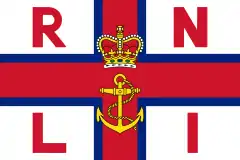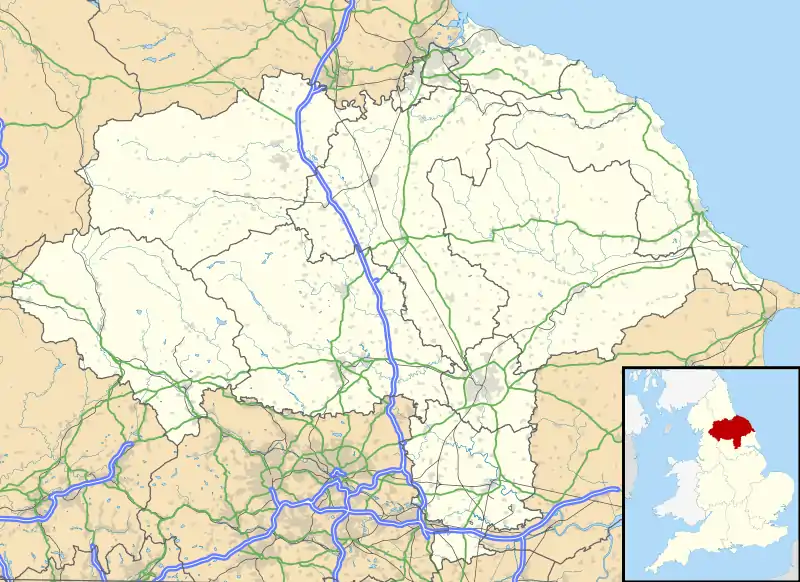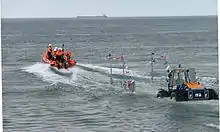Redcar Lifeboat Station
Redcar Lifeboat Station is a Royal National Lifeboat Institution (RNLI) lifeboat station based in the town of Redcar in North Yorkshire, England. The station is the furthest north in Yorkshire though there used to be one at Teesmouth, on South Gare and another further upstream on the River Tees in Middlesbrough.[1]
| Redcar Lifeboat Station | |
|---|---|
 | |
.jpg.webp) Redcar Lifeboat Station | |
 Location within North Yorkshire | |
| General information | |
| Type | RNLI Lifeboat Station |
| Location | Redcar, North Yorkshire |
| Country | England |
| Coordinates | 54.6185°N 1.0637°W |
| Estimated completion | 1970 |
| Owner | Royal National Lifeboat Institution |
| Website | |
| Official webpage | |
The station operates Inshore Lifeboats (ILB) with All-Weather Lifeboats being stationed at Hartlepool to the north, and Whitby to the south. Redcar operates two Inshore Lifeboats (ILB); the Leicester Challenge III and the Eileen May Loach-Thomas.[2]
History
A lifeboat first arrived in the town in 1802 having been financed by local fishermen.[note 1][3] She was constructed by Henry Greathead and when she arrived at Redcar, the settlement was a small fishing hamlet consisting of two rows of terraced houses; expansion was to come later.[4] The lifeboat was named Zetland and served the area and the Teesbay Lifeboat and Shipwreck Society until 1859 when the RNLI took over.[5] Under the auspices of the RNLI, she served for six more years before being damaged and scheduled to be broken up. However, the local population arranged for the boat to be kept, which the RNLI agreed to on condition that she not be used in competition with their replacement boat, Crossley.[6] The Crossley itself only lasted three years on the station; its self-righting buoyancy airboxes made the lifeboat too small and so the Burton-on-Trent was brought to the station in 1867. Whilst she was being unloaded, the lifeboat fell and crushed one of the men unloading her from a train.[7]
In the early days of the lifeboat station, before she was taken over by the RNLI, a drummer boy would alert the lifeboat crew to a launch by playing Come Along, Brave Boys, Come Along.[8] The lifeboat station itself was supplied by Lord Zetland, and the modern day (1970s) lifeboat station is located on this site too.[3]
A former lifeboat house was built in 1877 to house the lifeboat Emma and is now grade II listed.[9] In 1936 the RNLI purchased the building and it is now the lifeboat museum and houses Zetland, the world's oldest surviving lifeboat.[10] Emma was named after Emma Dawson and was a gift to the townspeople by local benefactors, but Emma and her lifeboat station were completely outwith the responsibilities of the RNLI, being purely a local concern with money and support also being provided by the Order of Free Gardeners.[10][11]
In 1910, the RNLI built a new lifeboat house on the promenade to house their boat (Fifi and Charles), the Emma having fallen into disrepair a decade earlier.[12] This building was in turn demolished in the early 1970s after a new lifeboat station was constructed next door.[13] In 1970, the County Borough of Teesside Council built a new lifeboat station for the RNLI on the seafront at Redcar.[14] In 2014 the exterior of the lifeboat station was refurbished after 40 years of being exposed to the weather rolling in from the North Sea.[15]
Notable incidents

- 7 September 1826 - A whaling ship, the Esk, returning to her home port of Whitby, was stranded on the rocks just outside Marske-by-the-Sea. The Redcar Lifeboat attended the wreck, but only three out of a crew of twenty-nine were saved.[16][17]
- 25 December 1836 - The Zetland was launched on Christmas Day to help a Dutch collier (Caroline) as she was foundering in heavy seas. One of the crew members was washed overboard whilst trying to throw a line to one of the Caroline's lifeboats. Neither the crewman nor the ten crew of the collier Caroline survived. The death of the lifeboat crewman remains the only death of a crewmember to have occurred at Redcar Lifeboat Station (though other deaths associated with launching have occurred [see below]).[18][note 2][19][20][21]
- 29 October 1880 - The Zetland was brought out of retirement to rescue the crew of the brig, Luna, after all other lifeboats were out of action due to having also rescued stricken crews on the same day. Zetland rescued the seven men from the Luna.[22][23]
- 18–22 October 1898 - The Finnish Barque, Birger. The Birger had been sailing from Barcelona to Finland carrying a consignment of salt. When she was approaching the coast of Norway, a fierce storm struck the North Sea which was to last five days. The south-easterly winds blew her towards Britain and her captain tried to make port first at Grimsby, but when this proved difficult, a decision was made to head for Newcastle. As she passed up alongside the Yorkshire Coast, the lifeboats and rockets were prepared at Scarborough, Robin Hood's Bay, Whitby, Runswick Bay and at Saltburn. Each time the stricken vessel passed by without being able to make port.[24] By the time of her arrival in Redcar (22 October), she was struggling against the storm and taking on significant amounts of water. She was wrecked on the rocks outside of Redcar and both lifeboats, Brothers and Emma, were launched to help rescue the men. The lifeboat crews could not find anybody and the Birger's sails collapsed into the boat. Three men made it to the pier at Coatham, and of those only one survived the waves and was hauled up onto the pier by the locals who had been watching the rescue. Another man was washed ashore; 13 other sailors drowned. The wreck of the ship then cut Coatham Pier in half.[25][26]
- 27 December 1906 - The Japanese liner Awa Maru became stuck on a reef outside Redcar (known as Westcar). The lifeboat Brothers was launched and had a successful initial rescue, but on a second try, the lifeboat had its back broken on the rocks. Despite this, they tried again only for the lifeboat's carriage to become embedded in the soft sand. The remainder of the crew of the Awa Maru managed to get ashore in their own lifeboats later. The ship had to be blasted away from the rocks, but she was successfully re-floated.[27]
- 21 January 1921 - The Redcar Lifeboat Fifi and Charles was sent out to effect a rescue of a Greek collier ship (Aphrodite) that had run aground just to the east of Redcar. Usually, the lifeboat was launched by horses but none were available, so a contingent of humans (mostly women) wheeled the boat down to the shoreline. One of the women undertaking this was crushed to death under the wheels of the trailer carrying the boat.[28] This led to the construction of a slipway onto the beach opposite the lifeboathouse.[29]
Fleet
| Dates in service | Class | ON[lower-alpha 1] | Op. No.[lower-alpha 2] | Name | Comments |
|---|---|---|---|---|---|
| 1802–1880 | Zetland | The world's oldest surviving lifeboat, Zetland, which was named after the Marquess of Zetland, saved 500 lives. She is now preserved in the Redcar lifeboat museum[30] | |||
| 1864–1867 | Crossley | The boat was deemed to be too small due to the addition of boxes with buoyancy to aid self-righting and was transferred to Middlesbrough[31] | |||
| 1867–1884 | Burton-on-Trent | [7] | |||
| 1884–1907 | The Brothers | Damaged whilst attempting to rescue the crew of the Awa Maru in December 1906.[32][27] | |||
| 1907–1931 | 577 | Fifi and Charles | |||
| 1931–1951 | 35ft 6in Self-righting motor-class | 737 | Louisa Polden | The first motorboat to serve at Redcar[33] | |
| 1951–1965 | 35ft 6in Self-righting motor-class | 881 | City of Leeds | [33] | |
| 1965–1972 | Liverpool-class | 892 | Aguila Wren | [34] | |
| 1972–1986 | Oakley-class | 975 | 37-08 | Sir James Knott | The last All-Weather Lifeboat (ALB) to serve at Redcar. The ALB coverage was supplied by neighbouring Teesmouth station and the Redcar Station became host to two Inshore Lifeboats (ILBs).[33] |
| 1986–1990 | Atlantic 21-class | B-520 | Wildenrath Whizzer | ||
| 1990–2001 | Atlantic 21-class | B-580 | Leicester Challenge | ||
| 1997–2007 | D-class | D-523 | Peterborough Beer Festival I | ||
| 2001–2012 | Atlantic 75-class | B-777 | Leicester Challenge II | [35] | |
| 2006– | D Class | D-660 | City of Leeds II | Stationed at Redcar as part of the relief fleet[36][37] | |
| 2007– | D-class | D-511 | Margaret | ||
| 2007–2014 | D Class | D-677 | Jacky Hunsley | [38][39] | |
| 2012– | Atlantic 85-class | B-858 | Leicester Challenge III | [40] | |
| 2015– | D Class | D-786 | Eileen May Loach-Thomas | [40] |
- ON is the RNLI's Official Number of the boat.
- Op. No. is the RNLI's Operational Number of the boat carried on the hull.
Notes
- Some sources claim the boat was built in 1800 and was first active at Spurn Point (Humber) before being sent to Redcar in 1802. Humber Lifeboat Station is listed as being in use by 1810, but most sources claim The Zetland, as she came to be called, was sent direct from Henry Greathead to Redcar.
- Three fishermen, E, J & R Picknett died whilst trying to rescue the crew of the steamship Honoria in 1901. Their names are annotated on the RNLI memorial in Poole, Dorset.
References
- Leach 2018, p. 106.
- "Redcar's lifeboats". rnli.org. Retrieved 8 March 2019.
- Cockcroft 1985, p. 26.
- Leach 2018, p. 15.
- Dibdin & Ayling 1894, p. 88.
- "Name Zetland | National Historic Ships". www.nationalhistoricships.org.uk. Retrieved 16 February 2019.
- Lloyd, Chris (7 July 2017). "Looking back: Not plain sailing for Redcar's newest lifeboat". Darlington and Stockton Times. Retrieved 16 February 2019.
- Chrystal, Paul (2017). The Place Names of Yorkshire; Cities, Towns, Villages, Rivers and Dales, some Pubs too, in Praise of Yorkshire Ales (1 ed.). Catrine: Stenlake. p. 67. ISBN 9781840337532.
- Historic England. "Zetland Lifeboat Museum and Redcar Heritage Centre, and attached wall (Grade II) (1329601)". National Heritage List for England. Retrieved 13 February 2019.
- Leach 2018, p. 109.
- Dibdin & Ayling 1894, p. 127.
- Leach 2018, pp. 108–109.
- Leach 2018, p. 110.
- "Redcar Lifeboat Station" (PDF). www.nia-uk.org. Hanson. p. 1. Retrieved 17 February 2019.
- "Hundreds witness sea rescue display". BBC News. 13 July 2014. Retrieved 17 February 2019.
- "SHIP WRECKS". Redcar.org. Retrieved 21 October 2019.
- Historic England. "Esk (937642)". PastScape. Retrieved 21 October 2019.
- "Remembering crewman's death". The Whitby Gazette. 1 January 2012. Retrieved 17 February 2019.
- Robson, Dave (20 May 2009). "Search for relatives of Redcar lifeboat heroine". Gazette Live. Retrieved 7 March 2019.
- "Station history | RNLI". rnli.org. Retrieved 7 March 2019.
- Cockcroft 1985, p. 84.
- "1880: The Zetland's final launch - Timeline - Our history - RNLI". rnli.org. Retrieved 17 February 2019.
- Methley, Noel (2015). The Life-Boat and its Story. Bremen: Maritime Press. p. 132. ISBN 9783954272358.
- Green, Gary (2002). "4. The Wreck of the Birger; a True Story of Heroism and Great Tragedy". In Anderson, Maureen (ed.). Aspects of Teesside : discovering local history. Barnsley: Wharncliffe Books. pp. 51–56. ISBN 1-903425-19-0.
- Lloyd, Chris (19 October 2018). "End of the pier story". Darlington & Stockton Times (42–2016). p. 37. ISSN 2516-5348.
- Cockcroft 1985, p. 80.
- Burbage, Claire (27 December 2006). "Redcar's last big rescue". The Northern Echo. Retrieved 22 February 2019.
- Robson, Dave (10 January 2009). "Tribute to our sea heroes: Memorial honour for those who gave their lives Lifeboats". Middlesbrough Evening Gazette. ProQuest 351273466.
- Chrystal 2012, p. 29.
- Winn, Christopher (2010). I never knew that about Yorkshire. London: Ebury. p. 74. ISBN 978-0-09-193313-5.
- Dibdin & Ayling 1894, p. 90.
- Dibdin & Ayling 1894, p. 91.
- "History – The Motor Lifeboats – Redcar RNLI". redcarlifeboat.org.uk. Retrieved 16 February 2019.
- "Name Aguila Wren | National Historic Ships". www.nationalhistoricships.org.uk. Retrieved 25 February 2019.
- "RNLI sets sail in £180k lifeboat". BBC News. 30 March 2012. Retrieved 16 February 2019.
- "RNLI Lifeboat is named after city". BBC News. 24 June 2006. Retrieved 21 February 2019.
- Rostron, Jo (21 February 2019). "New £25,000 lifeboat named City of Leeds II". Yorkshire Evening Post. Retrieved 21 February 2019.
- Chrystal 2012, p. 30.
- "Lifeboat named after crash victim". BBC News. 19 April 2008. Retrieved 4 March 2019.
- Leach 2018, p. 108.
Sources
- Chrystal, Paul (2012). Lifeboat Stations of North East England; From Sunderland to The Humber, Through Time. Stroud: Amberley. ISBN 978-1-4456-1376-5.
- Cockcroft, Janet (1985). Redcar and Coatham: a history to the end of World War II (3 ed.). Redcar: Sotheran. ISBN 0-905032-16-0.
- Dibdin, James; Ayling, John (1894). The book of the lifeboat : with a complete history of the Lifeboat Saturday movement. Edinburgh: O. Anderson & Ferrier. OCLC 4271825.
- Leach, Nicholas (2018). The Lifeboat Service in England; the North East Coast, Station by Station. Stroud: Amberley. ISBN 978-1-4456-6832-1.
- Philo, Phil (1993). Redcar: A Pictorial History. Chichester: Phillimore. ISBN 0-85033-864-6.
External links
| Wikimedia Commons has media related to Redcar Lifeboat Station. |